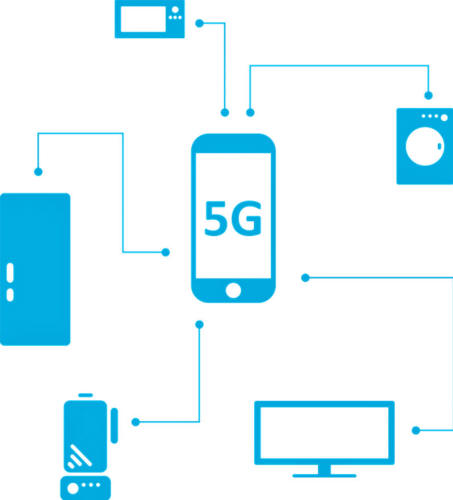|

by Jody McCutcheon
May 07, 2018
from
EluxeMagazine Website

As the old saying goes,
give us an inch and inevitably we'll want a
mile.
And certainly, this sentiment is true with technology.
Who doesn't want faster, bigger (or smaller), more efficient?
Take wireless mobile
telecommunications. Our current broadband cellular network platform,
4G (or fourth generation), allows us to transmit data faster than 3G
and everything that preceded. We can access information faster now
than ever before in history.
What more could we want?
Oh, yes, transmission speeds powerful enough to accommodate the
(rather horrifying)
so-called Internet of Things.
Which brings us
to 5G...
Until now, mobile broadband networks have been designed to meet the
needs of people.
But 5G has been created
with machines' needs in mind, offering low-latency, high-efficiency
data transfer. It achieves this by breaking data down into smaller
packages, allowing for faster transmission times.
Whereas 4G has a
fifty-millisecond delay, 5G data transfer will offer a mere
one-millisecond delay - we humans won't notice the difference, but
it will permit machines to achieve near-seamless communication.
Which in itself may open
a whole Pandora's box of trouble for us - and our planet...

More bandwidth
- more dangers of 5G
Let's start with some basic background on 5G technology.
Faster processing speeds
require more bandwidth, yet our current frequency bandwidths are
quickly becoming saturated.
The idea behind 5G is to
use untapped bandwidth of the extremely high-frequency millimeter
wave (MMW), between 30GHz and 300GHz, in addition to some lower
and mid-range frequencies.
High-frequency MMWs travel a short distance. Furthermore, they don't
travel well through buildings and tend to be absorbed by rain and
plants, leading to signal interference.
Thus, the necessary
infrastructure would require many smaller, barely noticeable cell
towers situated closer together, with more input and output ports
than there are on the much larger, easier to see 4G towers.
This would likely result
in wireless antennas every few feet, on every lamp post and utility
pole in your neighborhood.
Here are some numbers to put things into perspective:
as of 2015,
there were 308,000 wireless antennas on cell towers and buildings.
That's double the 2002 number.
Yet 5G would require
exponentially more, smaller ones, placed much closer together, with
each emitting bursts of radiofrequency radiation (RFR) -
granted, at levels much lower than that of today's 4G cell towers -
that will be much harder to avoid because these towers will be
ubiquitous.
If we could see the RFR,
it would look like a smog that's everywhere, all the time...

Serious health
concerns
First, it's important to know that in 2011, the World Health
Organization's International Agency for Research on Cancer
classified RFR as a
potential 2B carcinogen and
specified that the use of mobile phones could lead to specific forms
of brain tumors.
Many studies (Genetic
Effects of Radiofrequency Radiation) have associated low-level RFR exposure with a litany of
health effects, including:
-
DNA single and
double-strand breaks (which leads to cancer)
-
oxidative damage
(which leads to tissue deterioration and premature ageing)
-
disruption of
cell metabolism
-
increased
blood-brain barrier permeability
-
melatonin
reduction (leading to insomnia and increasing cancer risks)
-
disruption of
brain glucose metabolism
-
generation of
stress proteins (leading to myriad diseases)
As mentioned, the new 5G
technology utilizes higher-frequency MMW bands, which give off the
same dose of radiation as airport scanners.
The effects of this
radiation on public health have yet to undergo the rigors of
long-term testing.
Adoption of 5G will mean
more signals carrying more energy through the high-frequency
spectrum, with more transmitters located closer to people's homes
and workplaces - basically a lot more (and more potent) RFR flying
around us.
It's no wonder that
apprehension exists over potential risks, to both human and
environmental health.
Perhaps the strongest concern involves adverse effects of MMWs on
human skin.
This letter to the Federal Communications Commission,
from Dr Yael Stein of Jerusalem's Hebrew University, outlines
the main points.
Over ninety percent of
microwave radiation
is absorbed by the epidermis and dermis layers,
so human skin basically acts as
an absorbing sponge for microwave
radiation. Disquieting as this may sound, it's generally considered
acceptable so long as the violating wavelengths are greater than the
skin layer's dimensions.
But MMW's violate this
condition.
Furthermore, the sweat ducts in the skin's upper layer act like
helical antennas, which are specialized antennas constructed
specifically to respond to electromagnetic fields.
With millions of sweat
ducts, and 5G's increased RFR needs, it stands to reason that our
bodies will become far more conductive to this radiation.
The full ramifications of
this fact are presently unclear, especially for more vulnerable
members of the public (e.g., babies, pregnant women, the elderly),
but this technology
Furthermore, MMWs may cause our pain receptors to flare up in
recognition of the waves as damaging stimuli.
Consider that the US
Department of Defense already uses a crowd-dispersal method called
the
Active Denial System, in which MMWs are directed at
crowds to make their skin feel like it's burning, and also has the
ability to basically microwave populations to death from afar with
this technology if they choose to do so.
And the
telecommunications industry wants to fill our atmosphere with MMWs?

Other
distressing research
Unfortunately, innocent animals have already been the victims of
testing to see MMW's effects on living cells.
Extrapolating the results
from animal testing to humans isn't straightforward, but the results
nonetheless raise some serious red flags.
Perhaps most
significantly, a US National Toxicology Program
study noted that
male rats exposed to RFR for nine hours a day over two years
developed
rare forms of tumors in the brain and heart, and rats of
both sexes developed
DNA damage.
The researchers noted that the increased risk to the rats was
relatively small; but if these findings translate to humans, the
widespread increase in cellphone use could have a significant impact
on populations.
Thus the NTP study served
to renew the debate about the potential harmful effects of
cellphones on human health.
Not only that, it caused
a
significant shift in the American Cancer Society's understanding
of radiation and cancer, and sparked them to state that our
ignorance of RFR's impact on human health could be compared to our
previous obliviousness to the connection between smoking and lung
cancer.
Other animal research worldwide illustrates how microwave radiation
in general and MMW's in particular can damage the eyes and immune
system, cell growth rate, even bacterial resistance.
-
An
experiment at the
Medical Research Institute of Kanazawa Medical University showed
that 60GHz millimeter-wave antennas produce thermal injuries in
rabbit eyes, with thermal effects reaching below the eye's surface.
-
This study, meanwhile,
suggests low-level MMW's caused lens opacity - a precursor to
cataracts - in rats' eyes.
-
A
Chinese study demonstrated that eight
hours' of microwave radiation damaged rabbits' lens epithelial
cells.
-
A
Pakistani study
concluded that exposure to mobile phone EMF prevented chicken embryo
retinal cells from properly differentiating.
-
This
Russian study revealed that exposing healthy mice to
low-intensity, extremely high-frequency electromagnetic radiation
severely compromised their immune systems.
-
And a 2016
Armenian study
concluded that low-intensity MMW's not only depressed the growth of
E. coli and other bacteria, but also changed certain properties and
activity levels of the cells.
The same Armenian study
noted that MMW interaction with bacteria could lead to antibiotic
resistance - distressing news, considering immunity to bacteria is
already compromised due to the overuse of antibiotics.
Again, if these findings translate to humans, our rampant cellphone
use would likely cause profound, adverse health effects; an increase
in MMW's as more bandwidth is introduced could further complicate
the matter.
But what's also important
to note here is that 5G technologies will not only have a profound
impact on human health, but on the health of all living organisms it
touches, including plants, as we shall see.

5G harms the
planet, too
Equally disturbing, 5G technology puts environmental health at risk
in a number of ways.
First, MMWs
may pose a serious threat to plant health.
This 2010
study
showed that the leaves of aspen seedlings exposed to RFR
exhibited symptoms of necrosis, while
another Armenian study
suggested low-intensity MMW's cause "peroxidase isoenzyme
spectrum changes" - basically a stress response that damages
cells - in wheat shoots.
Plant irradiation is
bad news for the planet's flora, but it's bad news for us, too:
it could
contaminate our food supply.
Second, the 5G
infrastructure would pose a threat to our planet's atmosphere.
Network
implementation will require the deployment of many,
short-lifespan satellites via suborbital rockets propelled by
hydrocarbon rocket engines.
According to this
2010 California
study, launching too many of these babies will vomit enough
black carbon into the atmosphere to pollute global atmospheric
conditions, affecting distribution of ozone and temperature.
Worse, solid-state
rocket exhaust contains chlorine, an ozone-destroying chemical.
How can any government seriously concerned about climate change
allow for this?
Third, 5G will potentially threaten natural ecosystems.
According to several
reports over the last two decades - some of which are summarized
here - low-level, non-ionizing microwave radiation affects bird
and bee health.
It drives birds from their nests and causes
plume deterioration, locomotion problems, reduced survivorship
and death.
And bee populations
suffer from reduced egg-laying abilities of queen bees and
smaller colony sizes.
More evidence of
ecosystem disruption comes from this
2012 meta-study, which
indicates that 593 of 919 research studies suggest that RFR
adversely affects plants, animals and humans.
It bears repeating:
5G is bad news
for all living creatures and the planet we share.

Beware the
propaganda deluge
Despite being fully aware of all these unsettling results, threats
and concerns, the US
corporatocracy continues to maintain a gung-ho
attitude about 5G.
The
Mobile Now Act was
passed in 2016, and many US states have since
gone ahead with 5G
plans.
The telecom industry's
biggest players have basically co-opted government powers to enforce
their 5G agenda, with companies like AT&T and Qualcomm having begun
live testing.
And despite research
showing serious threats to humans and the planet, the FCC Chairman
announced intentions to open low-, mid- and high-frequency
spectrums, without even mentioning a single word about the dangers.
They're going to sell this to us as 'faster browsing speeds' - but
the truth is, you'll barely even notice the difference. They're
going to call anyone who protests against 5G a 'Luddite' or
'technophobe'.
But,
-
Why such a
willingness to embrace another new technology - even though
it carries serious risks and brings spurious benefits?
-
Why not heed the
lessons learned from killer products like asbestos, tobacco
and leaded gasoline?
Because,
-
a tiny percentage
of people will gain an awful lot of money, is one reason
-
companies and
governments will be given unprecedented amounts of power
over civilians
All isn't doom and gloom, though.
At least one US
politician is maintaining some level-headedness:
in October,
California Governor Jerry Brown stopped legislation that would
have allowed the telecom industry to inundate the state with
mini-towers.
Brown's bold actions
have permitted localities a say in where and how many cell
towers are placed.
The state of Hawaii
has
stopped 5G and smart meters by collectively threatening to charge
every person who installed such meters with liability for any health
problems residents may suffer.
Moreover, 180 scientists
have
started a petition to warn of 5G potential health effects.
Maybe these actions will
afford more time for additional studies and data collection.
Just as
importantly, maybe they'll cause other politicians and figureheads
to reflect on what they've been pushing for.
Take action
In the meantime, we as individuals must do everything we can to
protect ourselves. Here's what you can do:
-
Understand
EMFs
and their behaviors
-
Protect yourself
with an EMF Shield to mark and protect you from hotspots.
Try a
patented product that neutralizes the harmful effects
of mobile phones and other EMF emitting devices on humans.
-
Whenever
possible, limit your exposure: use an
anti-radiation headset
or speaker mode while talking on a cellphone.
-
Refuse to use 5G
phones and devices. Full stop. And discourage those you know
from doing so.
-
Refuse to buy
anything 'smart' - 'smart' appliances, 'smart' heaters, etc.
-
Carry
shungite
crystals to protect from radiation
-
No matter what,
do NOT get a
smart meter - these put high levels of 5G
radiation right in your home
-
Join the growing
numbers of dissenters.
Get active with them here.
-
Do as the
Hawaiians have done and threaten smart meter and 5G tech
installers with liability. You can learn
how to do that
here.
Even if the policy
drivers and governments aren't doing their due diligence, at least
we can say we're doing ours.
Sources
|







